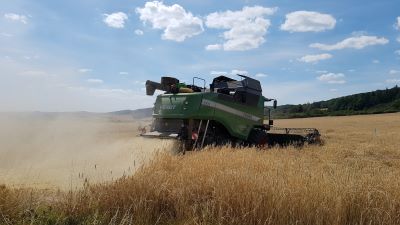Combine harvesting project
Coordinator: Prof. Dr. Rainer Waldhardt
Editor: Philipp Köllmann
Project runtime: 2018-2022
Funding: Federal Agency for Nature Conservation (Bundesamt für Naturschutz (BfN))
Main project partner: Landkreis Marburg-Biedenkopf
Main project:
Impact of an innovative combine harvesting technique on biodiversity - a pilot study of the administrative district of Marburg-Biedenkopf
Project module:
Impact of an innovative combine harvesting technique on the arable weed community in central Hessen/ Germany
Our agrarian landscape and agricultural practice have changed strongly over the last few decades. Intensification of farming methods with a high input of herbicides and fertilizers in conventional farming have resulted in a general loss of biodiversity and a homogenization of the landscape with less structure elements. Flora and fauna have been affected by this intensification development; many arable plant species that have been common a few decades ago have massively decreased in both species and individual numbers or vanished from arable fields. Wild arable plant species play an essential role in conservation of a high general biodiversity as these plant species provide a feed source for insects and birds and thus form the basis of the food chain.
With regard to the high proportion of agricultural used land in Germany (52%) the methods of farming will have a considerable impact for conservation biodiversity in general and conservation of arable plant species diversity.
The project aims is to test and develop a new combine harvesting technique that might be an approach for an alternative non-chemical weed control measure. In the project the administrative district of Marburg-Biedenkopf, nine regional farmers and the Justus-Liebig-University of Giessen are integrated.
Standard combine harvesters have the potential to spread weed seeds over vast areas of the fields, as weed seeds are ejected together with straw and chaff to the field. Basically, the new technique captures weed seeds and chaff in a separate container at the rear of the combine harvester before this material is released to the field.
Our research aims to find out if collecting weed seeds is affecting both – current coverage of arable plants and soil seedbank potential of these species in arable fields. Based on this research we can access if this combine harvesting technique has the potential to fulfill both – effective reduction of weed pressure and conservation of arable plant species diversity. Besides reducing weed pressure on arable fields we aim to separate the mixture of seeds and chaff into two main fractions: seeds that are useful for nature conservation measures and those seeds that often cause trouble in the farmers’ view; especially Galium aparine in cereal harvest.
The approach of a non-chemical weed regulation might be beneficial with regards to both ecological and economical aspects. Economic aspects are studied by the faculty of agronomy / Justus-Liebig-University of Giessen and will access the profitableness of the innovative harvesting technique.
Publications / Posters / Oral Presentations / Master's Thesis:
Ritz L (2023): Effekte innovativer Mähdruschtechnik auf Bodensamenbanken im Ackerland. Masterarbeit an der JLU
weed seeds in cropped fields of Marburg-Biedenkopf Country (Germany). Master's Thesis at Justus Liebig University Giessen and University of Prishtina (Kosovo)




